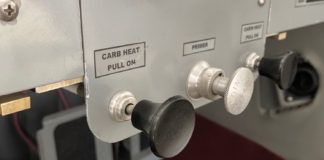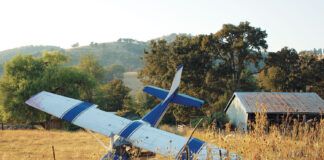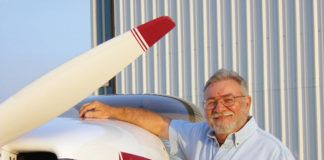I missed the boat on the flying-car dream. I’m too young to remember the hoopla in the 1940s and ’50s about flying cars. I’m also too old to be excited by the “Transformers” robots that turn into all kinds of modes of transportation. My early memories of transformable aviation came mostly from James Bond, who could stash aircraft in peculiar places like horse trailers (a jet) and suitcases (a gyroplane). And, yes, I’ll admit that one of the Bond villains had a flying AMC Matador, but that wasn’t exactly inspiring. (Frankly, I suspect the villain ended up flying it because it just wasn’t cool enough for Bond to fly himself. He does have an image to maintain!)
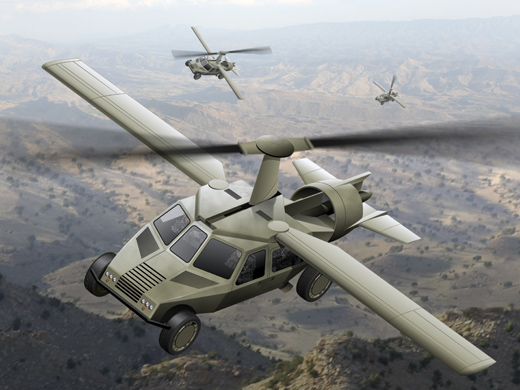
The Defense Advanced Research Projects Agency (DARPA) Transformer (TX) is the military’s research and development program for a flying car.
However, I admit to being intrigued by what seems to be a flurry of manufacturers pursuing flying cars. The suddenness may seem coincidental, but I don’t think it is. In fact, the Sport Pilot and Light Sport Aircraft regulations appear to have opened up more than just the flying-car idea. They have helped make new technologies available to put wings on cars.
Roadable Challenges
Many people immediately believe that the largest challenge for a new company is figuring out the technology it takes to build a flying car. That isn’t true. After all, flying cars in prototype form have been around since the 1930s, so the technology is attainable. But there are other challenges that must be met before the technology is ready for the marketplace. Just as important as having something that can be done is motivating someone to actually do it, and regulatory hurdles sometimes seem to quash good ideas.
Just certifying an aircraft is a tall, expensive order. For standard certificated aircraft, the FAA requires documentation, testing, documentation of testing, and documentation of documents before an airworthiness certificate will be issued. Automobile manufacturers don’t have it much easier. In fact, large car manufacturers get to do a lot of the same kinds of things aircraft manufacturers do, and then they crash a few samples to make sure they are crashworthy. (Imagine how much more expensive a Boeing 787 would be if the company had to build a few extra aircraft for crash testing.) So you can imagine the headaches that someone who wants to build a vehicle that both flies and drives is signing up for.
The LSA rules and, to a lesser extent, the Sport Pilot rating itself, reduced the FAA regulatory barriers for roadable aircraft and for those aspiring to fly them. Now for a two-place flying car, the possibility exists of getting one certified as a Special Light Sport Aircraft (SLSA). The cost of certification to the manufacturer, which ultimately ends up being added to the price of the flying car itself, was reduced by what economists call “a bunch.” That savings may help keep the price of the vehicles within the consumer’s grasp, at least the somewhat well-heeled one.
Luckily for the manufacturers, similar rules exist for low-volume automobile producers. This means that instead of two incredibly high barriers to leap, there are two medium-sized barriers to be cleared.
Demand and Supply
Getting a design certified is only part of the roadable-aircraft challenge. Somebody ultimately has to buy them. The two big potential customer pools are military/government and the general public. (No one has yet come up with a business-based use, though I suppose someone could redefine the term “air taxi.”)
The military has had a long interest in roadable aircraft, but much of the need for short-hop aircraft that can make it into undeveloped fields has been satisfied by helicopters. If small forces have to get into an area a little more quietly than a helicopter can, then walking, swimming or skydiving in from high altitudes seem to be the favored approaches. That isn’t to say there hasn’t been active interest on the military’s part. In fact the Defense Advanced Research Projects Agency (DARPA) is throwing money at this. What it wants is a four-place aircraft. It seems to be open-minded about whether the aircraft should be fixed or rotor wing, but it should be capable of vertical takeoff and landing (VTOL), so there may be considerable limitations right out of the gate.
Perhaps someday there will be a civilian version of whatever the military comes up with—like the Hummer. If there is, it may be as expensive for civilian pilots to own as a Hummer H3 has been for civilian drivers. But there is the hope that the technology that the feds and their contractors develop will be able to be scaled LSA or some other more affordable aircraft.
One of the big post-WW-II dreams was for everyone to have their own flying car, and that continues to be a primary pursuit of roadable-aircraft designers. Pursuing civilian customers involves solving a mix of challenges besides price. It isn’t just what you can build, it’s what you can build that enough people will write a check for.
One of the first considerations is convenience. After all, the attractiveness of a flying car is that you don’t have to go through the added effort of arranging for a rental car wherever you may land. If you need a team of mechanics to remove and stow the wings before you can drive away, then you have defeated the primary purpose. There are other issues such as range, style, speed, safety, supportability, maintainability and more, but if price and convenience issues can be met, sales will likely follow.
What’s Out There?
One of the nice things about the roadable-aircraft market is that it isn’t several companies all trying to do the same thing in the same way. Each company seems to have its own approach, which means that people will have a wider array of choices. So far, LSA-type companies are pursuing airplane, powered-parachute and gyroplane possibilities.
Airplane
Terrafugia (that’s Latin for “escape the Earth”) was founded in 2006, only a couple of years after the Sport Pilot and LSA rules went into effect. The company credits the new regulations for offering the opportunity to provide the public with a unique aircraft. During the last six years, the company has designed, driven and flown prototypes while at the same time building a market for the product by keeping the aviation world and the general public aware of its progress. This has been one of the benefits that companies like Terrafugia have provided the entire aviation community: a lot of good press. The non-flying public seems to be fascinated with aviation, but they are regularly fed a diet of aircraft accidents because they are rare enough to be considered news. Aircraft like Terrafugia’s Transition give the media something newsworthy to latch onto.
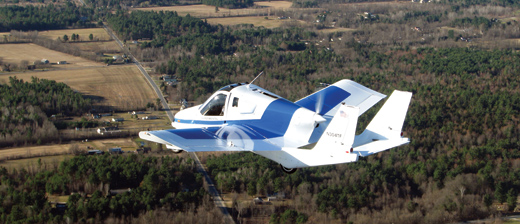
Terrafugia’s Transition looks like an airplane in flight.
The convenience of the Transition is hard to beat because the wings fold up with the touch of a button. When you’re back at the airport, you can redeploy the wings from inside the cockpit. That’s slick, and it’s what you’d expect from a team of engineers with MIT credentials.
Progress has been steady for the Terrafugia team. Obviously their investors take a long-term view, as development of such an aircraft takes time and talent. However, the investment should soon pay off. The production prototype flew in April, and there’s a plan to deliver the first production units this year. But the $279,000 base price is closer to the base price of a new Cessna 172 than it is to any LSA.

The Transition can make the conversion from road vehicle to airplane and back again from the cockpit.
Powered Parachute
When I mentioned markets for roadable aircraft, I purposely left out one niche market: missionary organizations. Missionaries often have some of the same challenges as the military, such as operating in rough terrain with bumpy or nonexistent roads. However, where the military seeks the enemy in the jungle, missionaries want to get to civilians and provide humanitarian assistance. Those differences mean that stealth and speed are less important for the missionaries. However, ease of use and low price are primary considerations.
The Indigenous People’s Technology and Education Center, or i-tec, got into the roadable-aircraft business serendipitously. The organization had long been using airplanes to reach remote areas, but airplanes require extensive training to operate as well as runways to take off from. Sometimes the people missionaries want to reach aren’t conveniently located near such runways.
Before Sport Pilot came into being, Troy Townsend approached Steve Saint, the founder of i-tec, about using powered parachutes in some of the most remote areas. Powered parachutes solved two big problems: levels of training and length of runways. The organization started requesting donations of powered parachutes that i-tec would then modify and send to both missionaries and the indigenous peoples themselves to use as transportation.

The Maverick actually looks like, well, a car in flight.
The powered parachutes worked out incredibly well. In some remote areas, it could take days to travel through mountains to get just a few miles; in a powered parachute, it takes only a few minutes. That’s the kind of place where a powered parachute is a practical form of transportation.
But even with the benefits of powered parachutes, Saint and Townsend could see further possibilities. What they wanted was a powered parachute that would carry a larger payload, drive over undeveloped terrain and be easier to take off in over shorter distances. They weren’t asking for much.
They started by solving an age-old problem for powered parachutes, the kiting of the parachute. Kiting the wing takes both skill and a good bit of runway, both of which are at a premium in undeveloped countries. They started working on a mast system to hold the parachute up before takeoff. They worked out bugs by putting the mast on existing powered parachutes. It was a telescoping pole that T’d off at the top to stretch out the leading edge of the parachute. By putting the parachute overhead and into position for flight, they reduced takeoff lengths significantly and made a powered parachute much simpler to fly. (Launching a powered parachute is the most complicated part of the flight.)
After solving the launching issue, it was natural to turn to larger airframes and engines to increase payloads. Like the Terrafugia Transition, the i-tec Maverick uses only one powerplant for both flight and ground operations. That saves on weight and makes the Maverick one potentially fast car on the ground. (The specifications say 100 mph.)
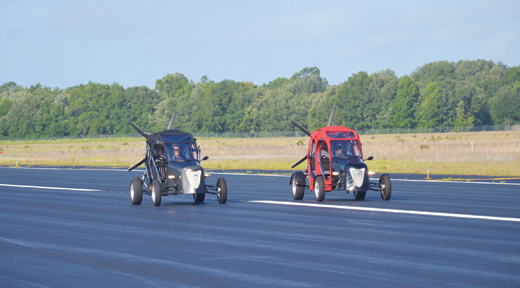
The Maverick from i-tec is the only flying car that is actually in production and being delivered. Yes, you can own one.
The Maverick is being offered in three versions: SLSA, ELSA and an Experimental-Amateur Built (E-AB) version. The big advantage of the E-AB version is that it seats up to four people, which means the pilot will have to be rated as a Private Pilot for powered parachutes in order to fly it in the U.S. The base price is $94,000.
Gyroplane
In the U.S., it is currently impossible to certificate a gyroplane as an SLSA. So it shouldn’t be surprising that, except for possibly the DARPA project and a couple of amateur-built projects, roadable gyroplanes are not seriously being worked on here.
However, that doesn’t mean that no one is looking at the possibilities. In the Netherlands, the Dutch government—along with private investors—is helping fund the development of a roadable gyroplane. The Dutch company PAL-V, which stands for Personal Air and Land Vehicle, was formed by a team of entrepreneurs with aviation, automotive, research and marketing expertise. The founders have also tapped into the expertise of the Dutch National Aerospace Laboratory and Delft University during the development of their product.

The PAL-V ONE on its maiden flight earlier this year.
The PAL-V ONE is a three-wheeled vehicle that the company says has the comfort of a car with the agility of a motorcycle due to Dynamic Vehicle Control (DVC), which is a mechanical-hydraulic system that takes the driver’s input from the steering wheel and distributes it between the front-wheel-steering angle and the vehicle-tilting angle. This distribution is automatically adjusted to varying speeds and road conditions to ensure an optimal balance at all times. At lower speeds, the steering torque is directed to the front wheel angle, and the passenger compartment remains upright. At higher speeds, the steering torque is mainly directed to the tilt angle of the cockpit. The PAL-V ONE sounds like a lot of fun and is described in the marketing literature as being like a sports car that drives through curves like a motorcycle.
The speeds and range on the vehicle are also impressive. In gyroplane mode, the range is up to 315 miles with speeds of 110 mph. On the ground, the PAL-V will have a range of 750 miles and a top speed of 110 mph (presumably ideal for those romps on neighboring Germany’s autobahns).
Converting from flight to driving mode is a semi-automated process that the company says takes about 10 minutes. The fully automated part happens when the engine stops—the propeller folds itself automatically into the driving position. Then the pilot can lower the rotor mast with the push of a button, which also lowers the tail. The pilot then folds the outer blades over the inner blades via hinge mechanisms. Finally, the pilot pushes the tail into its driving position and secures the rotor blades. To get the aircraft ready for flight, the process is simply reversed.
The design concept for the vehicle was set in 2008, with a driving prototype fully tested in 2009. Early this year, the gyro went on its first test flight. The company is hoping to begin delivering vehicles to the European market in 2014 at prices starting at around $300,000.
Filling the Skies?
The dreams seem to have been slightly scaled back from the idea of filling the skies with flying cars. Certainly the prices will keep most people in their current cars and aircraft. However, one of the things that kept the Ford company out of the flying-car market decades ago was the lack of an adequate air-traffic system. Perhaps the FAA is considering flying cars as it forecasts all of the increased traffic that will require the NextGen Air Transportation System.

![]()
Roy Beisswenger is the technical editor for Powered Sport Flying magazine (www.psfmagazine.com) and host of the Powered Sport Flying Radio Show (www.psfradio.com). He is also a Light Sport repairman and gold seal flight instructor for Light Sport Aircraft as well as the United States delegate to CIMA, the committee of the Fédération Aéronautique Internationale (FAI) pertaining to microlight activity around the world.

